On 29 September 1940, a mid-air collision occurred over Brocklesby, New South Wales, Australia. The accident was unusual in that the aircraft involved, two Avro Ansons of No. 2 Service Flying Training School RAAF, remained locked together after colliding, and then managed to land safely. Both navigators and
the pilot of the lower Anson bailed out after the aircraft struck.
The pilot of the upper Anson, however, found that he was able to control the interlocked aircraft using his ailerons and flaps, coupled with the still-functioning engines on the machine underneath. He then made an emergency landing in a nearby paddock. All four crewmen survived the incident, and the upper Anson was repaired and returned to flight service. No. 2 Service Flying Training School (No. 2 SFTS), based at RAAF Station
Forest Hill near Wagga Wagga, New South Wales, was one of twenty new pilot training facilities formed during World War II as part of Australia's contribution to the Empire Air Training Scheme. Having undergone basic aeronautical instruction at an Elementary Flying Training School, pupils received further instruction at SFTS that focussed on techniques they would require as operational (or "service") pilots, including instrument flying, night flying, cross-country navigation, advanced aerobatics, formation flying, dive bombing, and aerial gunnery. No. 2 SFTS's facilities were still under construction when its first course commenced with Avro Ansons on 29 July 1940.
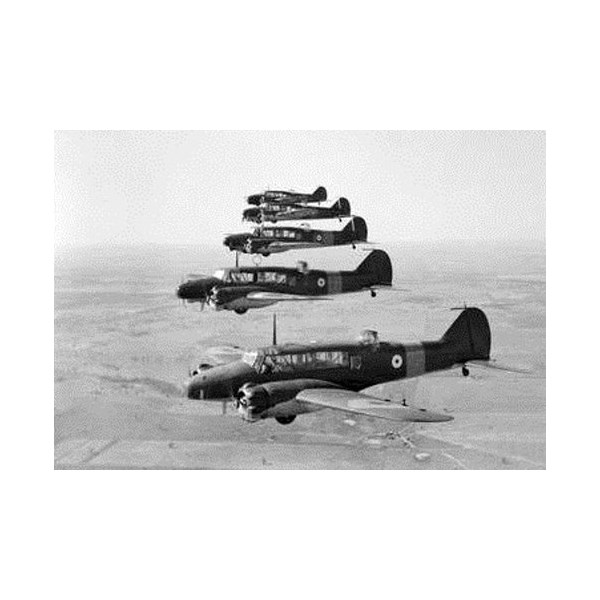
Ansons of No. 2 SFTS in formation

Sergeant Fuller (right) with Australian High Commissioner Stanley Bruce in London, 1941
On 29 September 1940, two Ansons took off from the
Forest Hill air base for a cross-country training exercise over southern New South Wales. Tail number N4876 was piloted by Leading Aircraftman Leonard Graham Fuller, 22, from Cootamundra, with Leading Aircraftman Ian
Menzies Sinclair, 27, from Glen Innes, as navigator. Tail number L9162 was piloted by Leading Aircraftman Jack Inglis Hewson, 19, from
Newcastle, with Leading Aircraftman Hugh Gavin Fraser, 27, from
Melbourne, as navigator. Their planned route was expected to take them first to Corowa, then to Narrandera, and finally back to
Forest Hill. he Ansons were at an altitude of 1,000 feet over the township of Brocklesby, near Albury, when they made a banking turn. Fuller lost sight of Hewson's aircraft beneath him and the two Ansons collided amid a "grinding crunch of metal and tearing of fabric". They remained jammed together, the lower Anson's turret wedged into the other plane's port wing root, and its fin and rudder balancing the upper Anson's port tailplane. Both of the upper aircraft's engines had been knocked out in the collision but those of the one below continued to turn at full power as the interlocked Ansons began to slowly circle. Fuller described the "freak combination" as "lumping along like a brick". Nevertheless, he found that he was able to control the piggybacking pair of aircraft with his ailerons and flaps, and began searching for a place to land. The two navigators, Sinclair and Fraser, bailed out, followed soon after by the lower Anson's pilot, Hewson, whose back had been injured when the propeller of the other plane sliced through his fuselage.
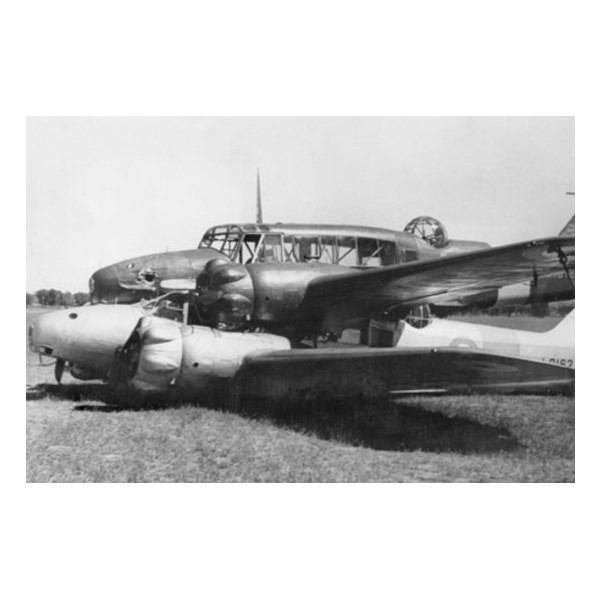
The Avro Ansons after landing safely

Engines and forward sections of the two aircraft
Having travelled five
miles since the collision, Fuller successfully made an emergency 'pancake' landing in a large paddock four
miles south-west of Brocklesby, coming to rest after sliding some 200 yards across the grass. As far as Fuller was concerned, the touchdown was better than any he had made when practising 'circuits and bumps' at
Forest Hill airfield the previous day. His acting commanding officer, Squadron Leader Cooper, declared the choice of improvised runway "perfect", and the landing itself as a "wonderful effort". The RAAF's Inspector of Air Accidents, Group Captain Arthur "Spud" Murphy was quickly on the scene, along with his deputy Henry Winneke. Fuller told Murphy:
“
Well, sir, I did everything we've been told to do in a forced landing—land as close as possible to habitation or a farmhouse and, if possible, land into the wind. I did all that. There's the farmhouse, and I did a couple of circuits and landed into the wind. She was pretty heavy on the controls, though!
The "freak flying experience" garnered news coverage around the world, and put Brocklesby "on the map". By preventing the Ansons from crashing, Fuller was credited not only with sparing Brocklesby possible destruction, but also with saving approximately £40,000 worth of military hardware. Both aircraft were repaired, the top plane (N4876) returning to flight service, and the lower (L9162) being used as an instructional airframe. Hewson was treated for his back injury at Albury District Hospital and returned to active duty, graduating from No. 2 SFTS in October 1940. He was discharged from the Air Force as a flight lieutenant in 1946. Sinclair was discharged in 1945, also a flight lieutenant. Fraser was posted to Britain and flew as a pilot officer with No. 206 Squadron RAF, based in Aldergrove, Northern Ireland. He and his crew of three died on 1 January 1942 during a routine training flight, when their Lockheed Hudson collided with a tree.
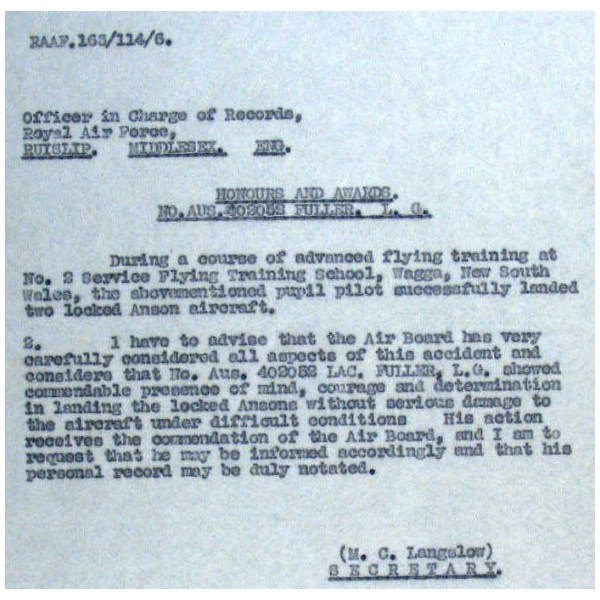
Fuller's Honours and Awards

Fuller's Conduct Sheet
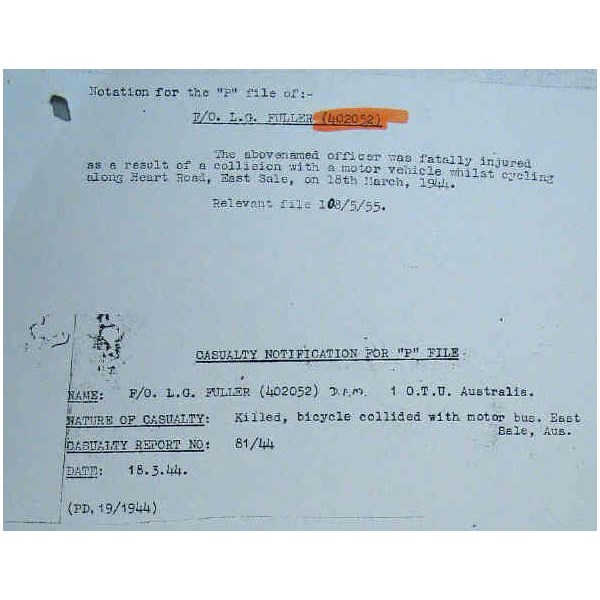
Fuller's Death Notification
Fuller was promoted to sergeant after his successful landing, but also confined to barracks for fourteen days, reportedly for speaking about the incident to the newspapers without authorisation. Graduating from No. 2 SFTS in October 1940 Fuller saw overseas service with No 37 Squadron RAF and was awarded a Distinguished Flying Medal (DFM) for operational flying over Palermo, Italy, and was also commissioned. Flying Officer Fuller returned to Australia to be an instructor at No 1 Operational Training Unit 1 OTU) at Sale, Victoria, and was killed in an accident on 18 March 1944 riding a bicycle near 1 OTU.
On 26 January 2007, a memorial to the 1940 collision, featuring an Avro Anson engine, was opened during Brocklesby's Australia Day celebrations.
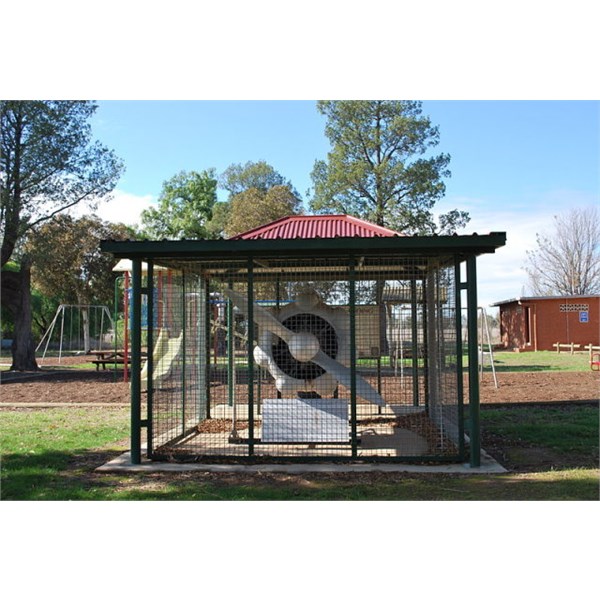
The monument to the accident in Brocklesby, 2009
.